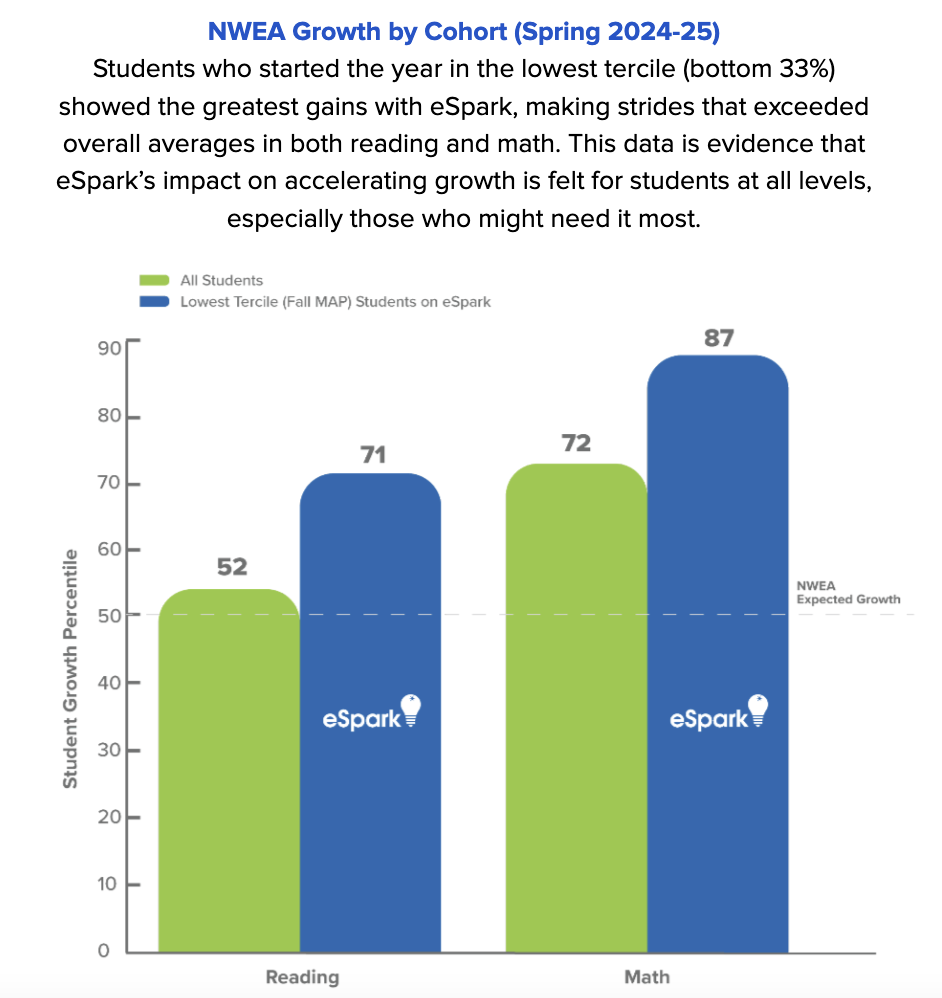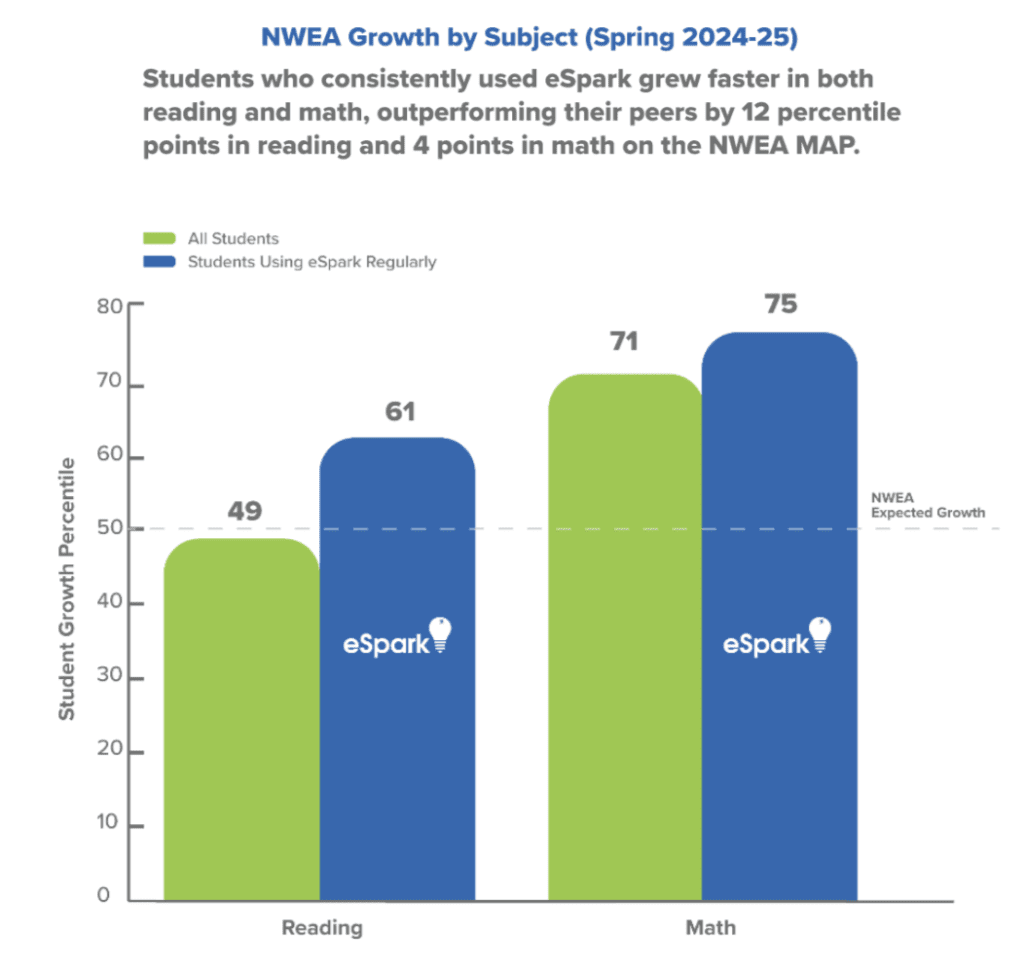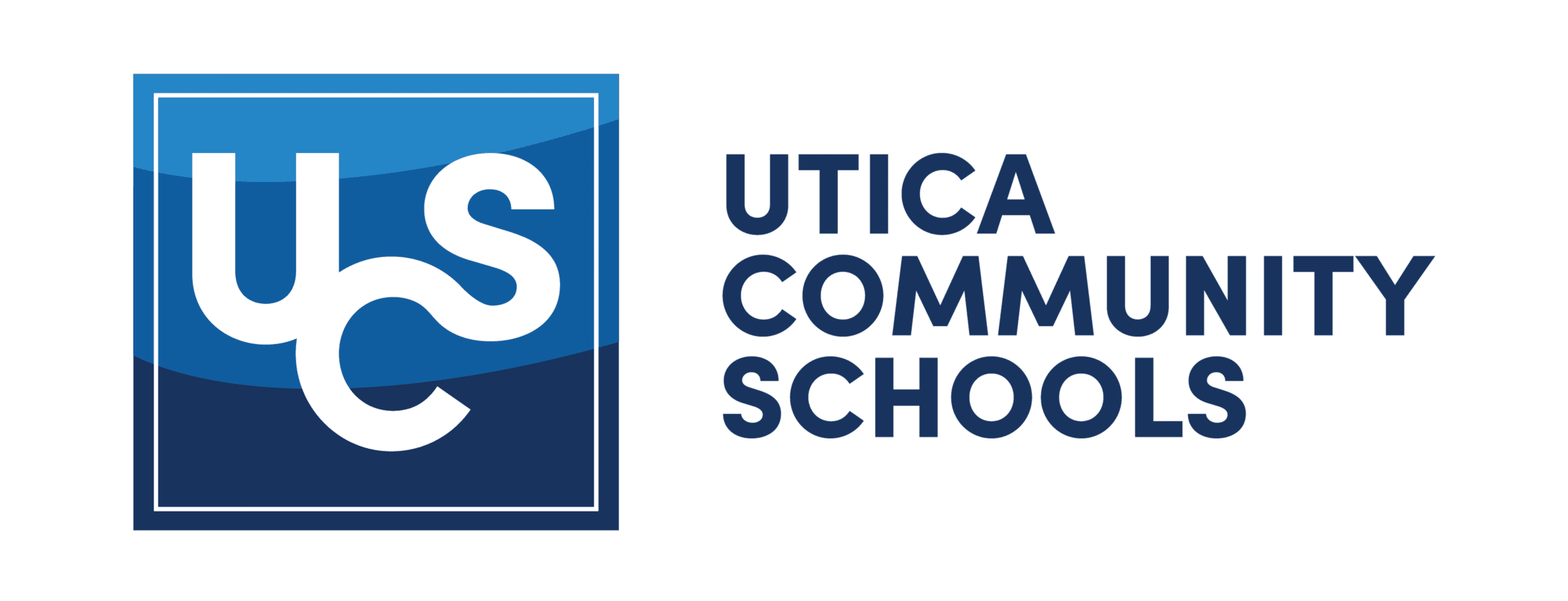Utica Community Schools first partnered with eSpark back in 2012 to enable easier differentiation for their teachers. UCS educators successfully achieved those goals, and now they’re pushing forward to tackle new challenges.
Early learning gaps have become increasingly evident nationwide following the COVID-19 pandemic. Narrowing those gaps while keeping students engaged in their learning is now the top priority for educational leaders. And although eSpark began at UCS as a solution for classroom differentiation, it has helped drive meaningful results across the board: students are active participants in their own learning, teachers feel supported, and district leaders point to measurable gains on NWEA MAP Growth assessments.
Together, UCS and eSpark show how personalized learning technology can amplify — not replace — the critical work of educators.
Quick Facts
- Scale: Partner since 2012 with consistent expansion
- Grades: K-3 general education, K-6 self-contained
- Subjects: Reading, Writing, Phonics, Math
- Assessment: NWEA MAP Growth
- Core Curricula: CKLA (Reading), Illustrative Mathematics (Math)
Building Skills Through Engagement and Belonging
As UCS faced widening early learning gaps and the lingering effects of pandemic disruption, leaders knew recovery was going to require more than academic support. Students needed to feel connected and valued to fully engage.
This commitment to connection was a priority even before the pandemic, as UCS was an early adopter of PBIS and restorative practices. But after the pandemic, many students re-entered school lacking strong oral language, early math foundations, or social skills. UCS leaders recognized the need for a solution that could close academic gaps while keeping learners engaged in the classroom from day one.
Catherine Einhaus, Executive Director of Elementary Curriculum and Programs, emphasizes that Utica sees wellness and social-emotional supports as integral to academic success:
“We can’t have good student achievement if we don’t have strong engagement, we don’t have kids that feel like they belong, or they don’t feel connected.”
— Catherine Einhaus, Executive Director of Elementary Curriculum at Utica Community Schools
In Ms. Calleja’s classroom at Beacon Tree Elementary, eSpark transformed learning into something students eagerly anticipate. Each day, they rotate through literacy and math centers, but the most anticipated stop is the eSpark station — a chance to dive into personalized Quests tailored to their interests.
Ms. Calleja describes how eSpark keeps every child in her classroom engaged, whether practicing letter sounds or solving math puzzles. For her, the platform feels like having a personal tutor for each student, one that not only adapts to their needs but frees her to focus on the learners who need extra support. She recalls seeing the turning point come for one particularly reluctant reader when he got to choose a passage about his favorite animals. Not only did he complete the activity, but he proudly shared his learning with classmates.
“Choice makes such a difference,” explains Ms. Calleja. “They feel in control of their learning, and that ownership builds confidence. For a five-year-old, that’s a big deal.” She’s seen students who once struggled to stay engaged now ask for more time in eSpark, proving that motivation grows when learning feels more personal.
“Meeting every student’s needs can be overwhelming. eSpark makes differentiated planning easy, and it’s fun for the students. They’re engaged, they’re excited.”
— Jenna Calleja, Kindergarten Teacher at Beacon Tree Elementary
Implementing the Solution at Scale
Since partnering with eSpark in 2012, UCS has expanded usage across several grades and programs. Today, K-3 general education classrooms and K-6 self-contained special education classrooms use eSpark during reading and math blocks, stations, and even snack time.
Melissa Klein, a 1st grade teacher at DeKeyser Elementary, finds eSpark Assignments particularly valuable for meeting the varying needs of all her students. She assigns lessons based on the skill that she’s teaching that week, so her students get extra practice on that skill.
“The thing that I like about eSpark is that I can challenge my students,” Ms. Klein shares. “If we’re doing R-controlled vowels, I can assign some at a first grade level and some at a second grade level. I can even put someone at a kindergarten level, and no one knows except for me.” This way, every student has the opportunity to build confidence and demonstrate growth, regardless of where they are in their own learning journey.
With eSpark Premium+, Utica classrooms benefit from adaptive Reading, Writing, Phonics, and Math content aligned to each learner. Activities are personalized to suit each student’s academic levels, current interests, and realtime responses, so that students stay engaged while they work on key skills.
District administrators point to that engagement and resulting teacher adoption as a sign of lasting success:
“I consistently hear from my teachers that they’re happy with eSpark. Their kids like it, they like it, don’t touch it.”
— Catherine Einhaus, Executive Director of Elementary Curriculum at Utica Community Schools
For Michigan’s second-largest district, this consistency across classrooms matters. By standardizing differentiated practice with eSpark, UCS has created a scalable model that supports equity and helps improve academic outcomes across all student populations.
Results That Matter
UCS measures academic progress using the NWEA MAP Growth assessment. In recent years, the district has seen notable percentile gains in both reading and math among students using eSpark, evidence that their playfully-personalized approach is driving meaningful results.
At UCS, the data reflects something even bigger: children finding their stride as learners. In reading, students who consistently used eSpark outpaced their expected NWEA growth by over 10 percentile points, demonstrating steady progress and building greater confidence in their own skills. In math, eSpark students again surpassed growth expectations. This time, they exceeded NWEA’s expected growth percentile by 25 points, highlighting their clear mastery of the math skills and standards they need to thrive.

For those students needing more intensive support, the results were especially encouraging. Learners beginning the school year in the lowest tercile (bottom 33%) made the greatest gains of all, meaning that educators were able to narrow the widest gaps present in their district.

These outcomes reflect what teachers at UCS witness every day: when students have choice, voice, and joy in their learning, they thrive. For Utica Community Schools, the impact has gone beyond stronger test scores — it has meant classrooms where children feel supported, teachers feel equipped, and growth is possible for every child.
Looking Ahead to New Opportunities for Growth
For UCS leadership, eSpark’s value lies not only in past results but in its ability to evolve alongside district priorities. Utica recently adopted a new reading curriculum, CKLA, and leaders are hard at work making sure that classroom instruction is aligned to CKLA’s scope and sequence for the year ahead.
Enter eSpark’s new teacher assistant, Nova: an AI-powered chatbot that finds, auto-differentiates, and assigns lessons directly aligned to a district’s core curricula. Now, every eSpark teacher at Utica has a way to ensure that their supplemental instruction or practice is always a direct extension of what they’re teaching in class.
As Catherine Einhaus notes, the results are already clear: students are building skills, confidence, and a love for learning… one personalized eSpark Quest at a time. District leaders view eSpark not just as a program, but as a long-term partner in shaping confident learners and sustaining growth.
“I love how eSpark is always evolving. You’re growing with the research and doing what’s best for kids.”
— Catherine Einhaus, Executive Director of Elementary Curriculum at Utica Community Schools


